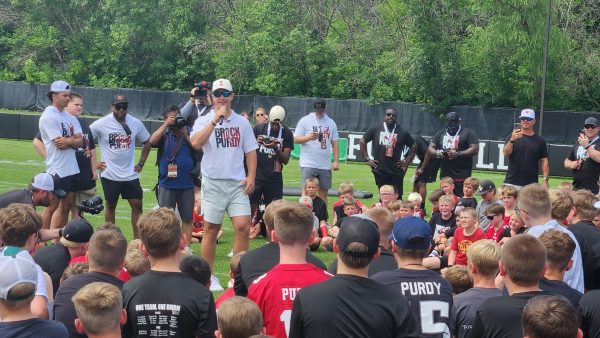Head to Head: Should there be fans allowed at football games this fall?
August 14, 2020
Iowa State Athletic Director Jamie Pollard outlined three possible options for fan attendance for Iowa State football games in a letter to fans Friday, giving clarity as to where Iowa State’s options stand as other members of the Big 12 have come out in recent weeks with their plans for fan capacity.
And with the season less than a month away for the Cyclones, a decision from Pollard and Iowa State Athletics is imminent.
With a decision on fan attendance coming in the near future, Iowa State Daily Sports Editor Zane Douglas and Assistant Sports Editors Matt Belinson and Stephen McDaniel decided to go “Head to Head (to Head)” and debate which of the three proposed options for fan attendance would be the best choice for Iowa State.
Belinson: No fans in the stands
I know this opinion technically makes me the bad guy in some people’s eyes, but believe me, there is nothing more electrifying than a packed stadium of 60,000 people on a Saturday afternoon watching some college football.
And that is why I think having no fans at all is the most reasonable and healthy option on the table.
There is no way stadiums can be filled to the brim like a typical season, so why should we kid ourselves and try and make the experience seem like this is a normal year? Spoiler alert: Nothing has been normal about 2020 and having stadiums with 25 or 50 percent capacity would be a lackluster way to try and recreate the magic of 60,000 fans yelling in celebration.
There is no feasible way to capture the true spirit of having fans in the stands this year, so why try it at all? The players, coaches and even concession workers will feel the awkward yells from fans 12 rows deep complaining about bad play calls and penalties.
Iowa State should go with the first option on the table and only allow the families and close friends of the players inside the stadium to watch home games this year.
Having only family and friends attending games will make this year a special experience for all of the players, being able to play the game they love while having their loved ones be right there with them.
Up until this point, I think the most logical choice based on the experience of the game environment is having no fans allowed. And I haven’t even mentioned COVID-19 yet.
I do think requiring masks at Jack Trice Stadium is a great idea and having no tailgating will ensure large crowds can’t gather before and after games, but as we have seen far too often this year, people don’t always make the best decisions for the greater good.
That means there will inevitably be some who will ruin the fun for everyone else and possibly spread the virus to someone who was trying to do the right thing. Having fans in the stands (who have not been placed in a bubble alongside Iowa State football players) opens up the door for much more risk than Iowa State should ask for.
Athletic department officials have worked hard to place student-athletes in protective bubbles, but if fans came back into the mix, you cannot tell me there wouldn’t be an increased risk for players and members of the athletic department contracting COVID-19.
I hate that I am in this position, having to argue against bringing fans back to games, but this is the safest option and there is no such thing as too much precaution during a global pandemic.
Douglas: 25 percent capacity
It doesn’t seem like an amazing idea to me to include any fans at the games, but there is a way this can be pulled off and it is a happy middle ground between absolutely no fans and 50 percent capacity.
The way this would work is every season ticket holder who bought season tickets would only receive three of six home games to attend. They may also move seats to encourage social distancing.
This is the compromise season ticket holders and the university should be looking for. The university gets to keep some of the money it would lose otherwise, but it also keeps things as safe as possible in the stadium.
I agree with Matt above on a lot of things. There is absolutely no way a stadium can be filled to the brim, but considering Jack Trice Stadium has open air flowing in and there are enough seats for one quarter capacity to social distance appropriately, this seems like the best course of action.
It should also be required that every fan wear a mask into the game, only removing the mask for eating purposes.
The risk fans bring to the stadium directly to the student-athletes in an open environment is little to none because it isn’t an enclosed space and because many, if not all, will be wearing masks.
Matt hit it on the nose about recent gatherings and how people won’t always make the decision for the greater good, but in this setting, there is nothing for these people to really risk as they won’t be next to anyone besides whoever they’re going with.
No tailgating certainly helps that and this will have to be met with cooperation from the fans, but something tells me fans who get to keep three games of their season tickets while being among the few to attend college football games this year will be enticing enough to not stir up too much trouble.
It’s unfortunate I have to pose this option with 50 percent being an option as well — I don’t think any of us want less fans at college football games — but it’s an important time in the country and the state of Iowa to make sure everyone is safe. The season will proceed, so safety is the most important measure here.
The recent assembling at Iowa State among students could mean students may not find themselves back in the stadium for awhile, but for season ticket holders, this is a solid idea that is low risk. Without jeopardizing safety, 25 percent capacity can bring fans to football games this season.
McDaniel: 50 percent capacity
Before I even list my argument for this, trust me I know why there would be much concern if Pollard and the athletic department went with this option, but hear me out.
With 50 percent capacity, Jack Trice Stadium would be seating roughly 30,000 fans into its stands for the upcoming football season and Pollard’s letter to fans already mentioned they’ve sold enough tickets for a 50 percent stadium capacity crowd.
Now I know I look and sound insane for arguing Iowa State should invest in allowing this amount of people into one stadium, but keep in mind there are and will be plenty of precautions put in place to ensure everyone’s safety.
First and foremost, Pollard made it clear every individual that attends a football game, regardless of where they’re seated, will be required to wear face coverings. This is a crucial requirement if Pollard and company want fans and it’s one of the first things they’re implementing if they go with one of two options that includes fans.
In addition to the tickets sold, Pollard also mentioned the 50 percent option would allow all of the fans to attend every home game instead of half. This option would also spread the fans out around the stadium to put as much distance between fans as possible, where the 25 percent would place fans in their normal seats.
As already mentioned before, Iowa State is also going to be thinning out the crowd come football season by restricting tailgating and RVs from university-owned lots, which really clears the area surrounding Jack Trice Stadium and allows those coming into the stadium a clear path where they don’t have to worry about interactions with other fans.
Along with that, Pollard also announced in his letter concessions will be limited to water and soda with no food options in order to limit the interactions between fans and stadium workers. Fans are still able to bring their own snacks as long as it follows Iowa State’s clear bag policy.
The atmosphere the Jack Trice crowd provides has become a signature of Iowa State football. Without fans in the stadium, teams really lose out on one of the biggest advantages of having “home field advantage.”
If the safety precautions Pollard and the Iowa State athletic department put into effect are followed and can properly manage and socially distance those 30,000 fans, this seems like the best option.
Pollard even mentioned in his letter, “The safety of all participants, fans and workers remains our top priority.”

















